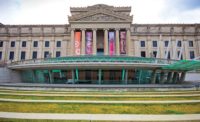The results of a recent opinion survey show that architects are split almost down the middle on whether building safety and security has taken center stage in their practices since the Sept. 11, 2001, terrorist attacks. In the poll, 55% of the 400 respondents say that building security is a higher priority for their clients. But only 46% say that at least one client has ordered implementation of security features for an existing building or one under design.
In the survey conducted by the American Institute of Architects, Washington, D.C., 48% of respondents say that buildings are "better protected against terrorist attacks" than they were a year ago. And 43% say the Sept. 11 massacre has "affected" how they and their clients approach work.
 |
| NEW YORK TIMES TOWER Plans were tweaked for added security. (Photo courtesy of Jock Pottle/Esto) |
More than half of those surveyed say clients for justice, government and other public buildings are requesting security features. But only 24% say office building clients are doing the same, and only 3% say their retail and hotel clients seek more security in their buildings.
In New York City, especially sensitive to terrorist acts, there are some high-profile security enhancements on high-rise buildings. These include hardening of critical structural elements, installing laminated glass and adding extra spray-applied fireproofing. The nearly 25-year-old Citigroup Center, with its "vulnerable" freestanding column streetside, is getting an upgrade. And there have been adjustments to the plans for the 52-story New York Times building, set to begin construction in the spring.
But major cities aside, "there is not much interest in security retrofits," says Tod Rittenhouse, a principal in Weidlinger Associates Inc. Consulting Engineers, a New York City-based firm that does blast assessment.
Nevertheless, Weidlinger's blast work has tripled since Sept. 11, 2001, with no let-up in sight. "Of the people who call us, 75% do vulnerability assessments," says Rittenhouse, and probably 25% of those take action.
Since the attacks, Weidlinger's client base has expanded. There are more owners of high-rises, iconic low-rise buildings, civic facilities, transportation hubs and sports venues.
Owners of arenas and stadiums are particularly concerned. "Across the board, owners and operators of public assembly facilities have reassessed current conditions" relating to security, both on the physical and operational side, says Russ Simons, a principal of HOK Sport + Venue + Event, Kansas City, Mo.
 |
| CITIGROUP CENTER Work under way on major freestanding column exposed to the street. (Photo by Nadine M. Post for ENR) |
Simons is the moderator for an Oct. 3 audio and Internet conference on emergency preparedness sponsored by the International Association of Assembly Managers, Coppel, Texas. Initially, "everyone circled their wagons," took stock of facilities, adjusted operations and added physical barriers, says Simons. "Now, they are beginning to implement long-term capital improvements," he says.
In the office arena, the San Francisco office of architect Gensler is developing construction documents for security upgrades at buildings around the globe. The budget is "hundreds of millions" of dollars. The client, a New York City-based financial firm, will not release details.
Financial firms are not the only owners gagging their consultants regarding security. Some won't even admit to retrofits. Karen Nelson, a spokeswoman for the Getty Center museum in Los Angeles, declined to comment on any plans because, she says, "it makes what we do a lot less of a surprise."



Post a comment to this article
Report Abusive Comment